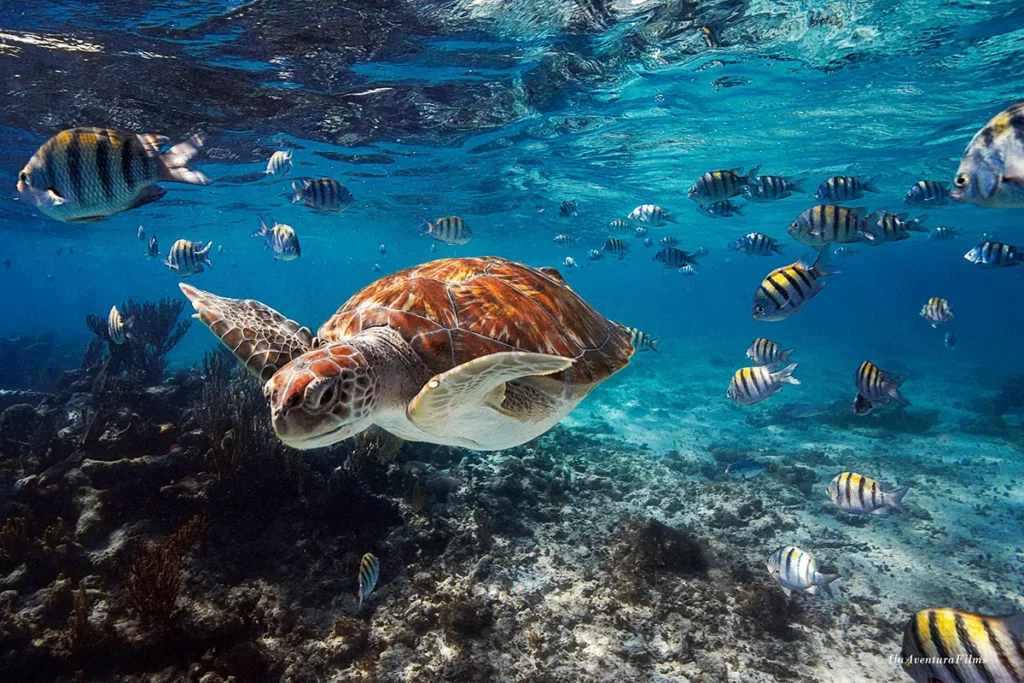
Introduction: Discover Cozumel’s Underwater Ecosystem
Cozumel, Mexico, is celebrated worldwide as a haven for marine biodiversity. Located within the Mesoamerican Barrier Reef System, the second-largest reef in the world, Cozumel’s waters are home to an extraordinary array of marine species. From vibrant coral formations to majestic sea creatures, this island offers unparalleled opportunities for exploration and appreciation of marine life. However, this underwater paradise faces increasing environmental challenges that threaten its delicate ecosystems.
In this blog, we’ll delve into the rich biodiversity of Cozumel’s reefs, explore their ecological importance, and discuss the threats they face—and what we can do to protect them.
1. The Rich Biodiversity of Cozumel
Coral Reefs: The Foundation of Life
Cozumel’s coral reefs serve as the foundation of its marine biodiversity. These living structures provide shelter, breeding grounds, and feeding areas for countless marine organisms. Hard corals, such as brain and star corals, build massive formations, while soft corals like sea fans and whips add texture and movement to the underwater landscape.
Fish Species
Cozumel’s reefs are home to over 500 species of fish. From the colorful parrotfish that help maintain coral health by grazing on algae to elusive moray eels hiding in crevices, each species plays a vital role in maintaining ecological balance. Larger predators like barracudas and groupers keep prey populations in check, ensuring a healthy food chain.
Marine Mammals and Sea Turtles
Dolphins and manatees occasionally visit Cozumel’s waters, delighting divers and snorkelers. Sea turtles, including loggerheads and green turtles, are frequent visitors, often spotted gliding gracefully through the reefs or resting in sandy patches.
Invertebrates and Crustaceans
Spiny lobsters, octopuses, and colorful shrimp are just a few of the invertebrates adding to the reef’s diversity. Nudibranchs—vibrantly colored sea slugs—offer photographers stunning macro opportunities.
2. The Ecological Importance of Coral Reefs
Coral reefs are often referred to as the “rainforests of the sea” due to their exceptional biodiversity. They play several crucial roles in the marine ecosystem:
- Habitat Creation: Reefs provide shelter for approximately 25% of all marine species.
- Coastal Protection: Coral structures act as natural barriers, protecting coastlines from erosion and storm surges.
- Nutrient Cycling: Reefs facilitate nutrient exchange, supporting marine food webs.
- Economic Value: Tourism, fisheries, and recreation generate billions of dollars globally, and Cozumel heavily depends on its reefs to attract visitors.
3. Threats Facing Cozumel’s Coral Reefs
Despite their beauty and ecological importance, Cozumel’s reefs are under threat from multiple human and environmental pressures:
Climate Change
Rising sea temperatures cause coral bleaching, where corals expel the algae (zooxanthellae) that provide them with food and color. Prolonged bleaching can lead to coral death.
Ocean Acidification
Increased CO2 levels result in more acidic oceans, weakening coral skeletons and making it harder for reefs to grow and recover.
Overfishing
Unsustainable fishing practices can disrupt the balance of predator-prey relationships, leading to overgrowths of algae that smother corals.
Pollution
Runoff from agriculture and urban areas introduces chemicals and nutrients into the water, causing algal blooms that block sunlight and deplete oxygen.
Tourism Impact
While tourism fuels Cozumel’s economy, poorly managed activities can lead to physical damage to reefs. Careless anchoring, snorkeling, and diving can break corals and disturb marine life.
4. Conservation Efforts and Sustainable Practices
Marine Protected Areas
Cozumel Reefs National Marine Park was established to safeguard these ecosystems. Strict regulations help minimize human impact while promoting responsible tourism.
Coral Restoration Projects
Several initiatives focus on coral propagation and transplanting healthy corals to damaged areas, fostering reef recovery.
Sustainable Tourism
Local dive shops and tour operators adhere to eco-friendly practices, such as using mooring buoys instead of anchors and educating visitors on reef preservation.
Community Involvement
Educational programs and clean-up campaigns raise awareness and encourage locals and tourists alike to take part in protecting the reefs.
5. How You Can Help Protect Cozumel’s Reefs
- Choose Eco-Friendly Operators: Dive with companies committed to sustainable practices.
- Avoid Touching Corals: Maintain buoyancy control to prevent accidental damage.
- Use Reef-Safe Sunscreen: Protect corals from harmful chemicals found in regular sunscreens.
- Reduce Plastic Waste: Bring reusable water bottles and bags to avoid single-use plastics.
- Support Conservation Efforts: Donate to or volunteer with organizations working to protect reefs.
Conclusion: A Call to Action
Cozumel’s marine biodiversity is a treasure worth protecting. Its reefs not only dazzle with beauty but also sustain complex ecosystems and human livelihoods. As you plan your visit—perhaps staying at the luxurious Casa 51 villa—take the time to appreciate and respect this fragile environment.
By choosing sustainable practices and spreading awareness, we can ensure that Cozumel’s underwater paradise continues to thrive for generations to come. Dive in, explore, and become an advocate for ocean conservation!
